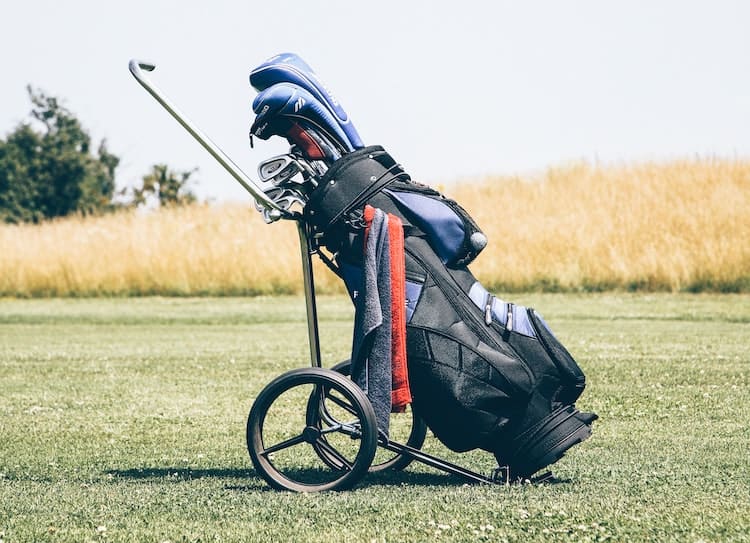
Identifying the ideal golf clubs for your game is a challenging endeavor. There are countless brands and any type of clubs you could desire, it is difficult to know where to start. However, before you start your search, you need to know how many golf clubs are in a bag.
From there, it enables you to remove any unnecessary options from the shopping list and allows you to focus on what is important. In this post, I explain how many clubs you can carry in your bag and how to select the correct tools for your swing.
How Many Golf Clubs You Can Have in Your Bag
USGA rules dictate the maximum number of golf clubs you carry in your golf bag is fourteen. There is no legislation dictating which fourteen clubs you can carry. The decision is up to you.
If you are caught with more than fifteen clubs in your bag, you are assessed a penalty. If you are playing stroke play, you receive a two-stroke penalty for the hole that you realize you are in breach of the rules of golf.
A famous scenario occurred in the final round of the 2001 Open Championship. After birding the first and moving into a tie for the lead, Ian Woosnam realized he had an extra fairway wood in his bag, taking his tally to fifteen. He received a two-shot penalty on the second tee box and continued to slide down the leaderboard.
Contrarily, if you are playing in a matchplay tournament, you will lose every hole that you had a 15th club. Say you play three holes before noticing you are in violation of the 14-club rule, then you lose those three holes and be three down.

For example, you can carry two or three putters, and nobody cares as long as there are no more than fourteen in the bag. I don’t recommend doing this, but it highlights that the type of clubs are irrelevant as long as the limit is not exceeded.
Conversely, you can carry less than fourteen clubs if you wish. During practice rounds, I often do this to force myself to get creative with a selection of shots.
How Many Golf Clubs You SHOULD Have in Your Bag
Where possible, I advise carrying all fourteen clubs in your bag. I say this because a complete set equips you for any scenario. You don’t want to be caught out with distance gaps because of insufficient wedges or woods.
As a junior, I only carried seven clubs. Two woods, three irons, a pitching wedge, and a putter. It was enough to get me around the course when distance gaps were not a problem. However, as I got older and hit the ball further, I needed more clubs to enhance my performance.
My current setup looks like this :
- 8-degree driver
- 14-degree 3-wood
- 20-degree 7-wood
- 3-iron to 9-iron
- 45-degree pitching wedge
- 54-degree sand wedge
- 60-degree lob wedge
- Two-way blade putter
Now, my bag features some strange selections, so let me list the necessary clubs you should have in your bag to get around the course.
In essence, you need at least ten clubs to get around the golf course. However, that will leave gaps in your distance and make life more difficult. My advice is to take advantage of the 14-club rule and fill your bag.
How to Decide Which Clubs You Should Carry in Your Bag
Choosing your fourteen clubs can give you sleepless nights in the build-up to purchasing new clubs. I recommend visiting your local fitment center for expert advice on which clubs to select. They will help you fill any distance gaps and determine if you need steel shafts on your irons or a graphite shaft on your fairway woods.
Those unable to get fitted can take a leaf out of my book. Contrary to other amateurs, I start with looking at my wedges. I would rather have more wedges and fewer woods because I gain most of my strokes by scrambling around the green.
Professional golfers and amateurs all need a pitching wedge, so start there. That leaves you with thirteen clubs to choose from. Since there is a giant gap in my distance between a pitching and sand wedge, I carry a gap wedge.
Finally, we are left with a choice of sand and lob wedges. The average golfer should opt for a sand wedge, as it is easier to control the launch and spin over a lob. In addition, a sand wedge is ideal for bunker shots.
Once you have your wedge in order, work back from your 9-iron. Make sure that it is no more than six degrees stronger than your pitching wedge choice. Then add an 8, 7, and 6-iron. Those comfortable with launching an iron can add a 4 or 5-iron into the mix.
If you struggle to launch your irons, opt for a 4 or 5-hybrid. Finally, the longer clubs. Whether you have a 4-iron or 4-hybrid, it is worth adding a 5-wood, 3-wood, and finally, a driver.
I suggest employing a launch monitor to help you analyze the best lofts for each iron based on distance and accuracy.
Overall, you should decide which clubs are best for you based on how straight and far you hit each shot. Selecting excess fairway woods and hybrid golf clubs leaves you light in your wedge artillery.
A lack of tools for around the green and short approach shots can cause you to leak strokes.
I used to battle with a gap in distance between my pitching and sand wedge. That led to numerous duffed shots with a half pitching wedge or forced sand wedge.
I kick myself for all the strokes I have wasted after bombing a drive to within 70-yards of the green. Avoid my mistakes, and pay more attention to the importance of your short game club selection.

